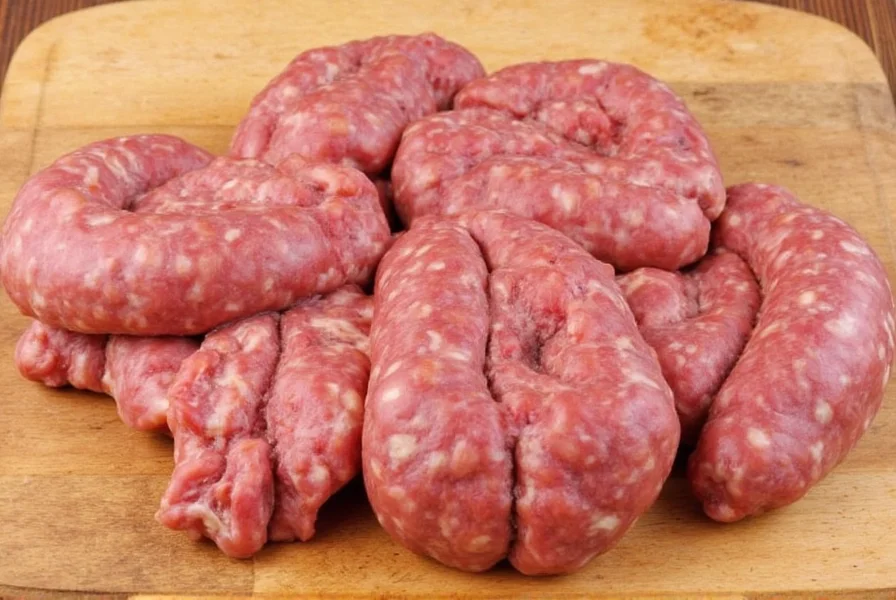Discover what truly makes sausage exceptional: the science of flavor, meat selection, and traditional techniques. This guide explains why certain ingredients and methods create unforgettable sausage experiences, with expert insights into flavor science and culinary craftsmanship.
| Key Factor | Why It Matters | Real-World Examples |
|---|---|---|
| Meat Composition | Lean-to-fat ratios affect texture and juiciness; pork (70% lean/30% fat) creates ideal mouthfeel | German bratwurst uses 70% pork shoulder, 30% pork belly for perfect balance |
| Spice Chemistry | Specific compounds in spices interact with meat proteins to create complex flavors | Paprika's capsanthin binds with fat for smoky depth; cumin's cuminaldehyde enhances savory notes |
| Casing Technology | Natural casings allow moisture retention and "snap" texture; synthetic casings provide consistency | Italian sausage uses natural hog casings for authentic bite; commercial sausages often use collagen for uniformity |
| Cooking Science | Maillard reaction and fat rendering at specific temperatures develop signature flavors | Grilling at 350°F creates optimal browning; smoking at 165°F preserves moisture while adding flavor |
The Flavor Science Behind Sausage
Sausage greatness comes from precise culinary chemistry. The interaction between meat proteins, fat molecules, and spice compounds creates complex flavor profiles that simple meat cannot achieve. For example:
- Protein denaturation: When meat is ground and mixed with salt, myosin proteins unfold and bind fat particles, creating stable emulsions that retain moisture during cooking
- Flavor synergy: Garlic's allicin combines with paprika's carotenoids to create layered umami notes that can't be replicated with single spices
- Texture engineering: The right fat percentage (typically 25-35%) ensures juiciness without greasiness while providing structural integrity
Traditional sausage makers understand these principles instinctively. Modern food scientists have confirmed that the ideal sausage requires specific chemical interactions between ingredients to achieve optimal flavor release during cooking.
Meat Selection: More Than Just the Cut
Not all meat is created equal for sausage making. The animal's diet, age, and muscle composition dramatically affect final product quality:
- Pork shoulder: 70% lean, 30% fat ratio makes it the gold standard for most sausages; contains ideal marbling for moisture retention
- Beef chuck: Higher fat content (25-30%) creates richer flavor but requires careful spice balancing
- Wild game: Leaner cuts (venison, elk) need 20-25% added pork fat to prevent dryness
Proper meat selection accounts for 40% of sausage quality according to food science studies. The right meat provides the foundation for all other flavor components to shine.
Spice Chemistry: The Flavor Architects
Spices don't just add flavor—they create complex chemical reactions that transform meat:
Key spice interactions:
- Paprika + fat: Capsanthin molecules dissolve in fat, creating smooth, smoky flavor distribution
- Cumin + salt: Enhances savory notes through sodium ion interactions with flavor receptors
- Fennel + garlic: Creates synergistic flavor compounds that amplify sweetness and complexity
Professional sausage makers use precise spice measurements (e.g., 1.5% paprika by weight) to achieve consistent flavor profiles. The wrong spice ratio can completely alter the sensory experience.
Traditional Techniques vs Modern Science
Centuries of sausage-making tradition have been validated by modern food science:
- Emulsion stability: Traditional mixing techniques (2-3 minutes at low speed) create stable fat emulsions that prevent grease separation during cooking
- Temperature control: Keeping meat below 40°F during processing prevents fat smearing and maintains texture
- Casing selection: Natural casings allow better smoke penetration and moisture retention than synthetic alternatives
These scientific principles explain why traditional methods continue to produce superior results despite modern alternatives.
FAQ: Sausage Science Explained
What makes sausage different from plain ground meat?
Sausage creates complex flavor through precise ingredient interactions: salt denatures proteins to bind fat, spices create chemical reactions with meat compounds, and casing technology controls moisture release during cooking. This transforms simple ground meat into a cohesive flavor experience.
Why does sausage need fat?
Fat serves three critical functions: 1) Provides mouthfeel and juiciness 2) Dissolves and carries flavor compounds from spices 3) Creates stable emulsion structure during processing. The ideal fat percentage (25-35%) ensures optimal texture without greasiness.
How do spices actually work in sausage?
Spice compounds interact with meat proteins and fat molecules through chemical reactions. For example, paprika's capsanthin binds to fat particles, creating smooth, even flavor distribution. Garlic's allicin combines with meat compounds to create new savory notes that don't exist in raw ingredients.
Why do some sausages taste better than others?
Superior sausages balance four key factors: 1) Optimal meat-to-fat ratio 2) Precise spice chemistry 3) Proper emulsion formation 4) Scientific cooking techniques. Small variations in these elements create dramatically different sensory experiences.











 浙公网安备
33010002000092号
浙公网安备
33010002000092号 浙B2-20120091-4
浙B2-20120091-4